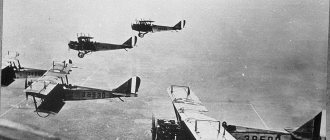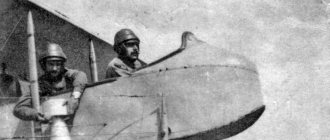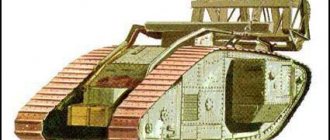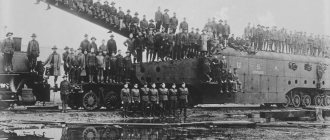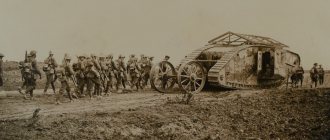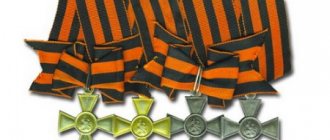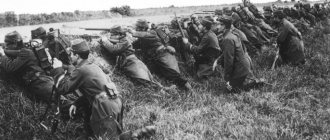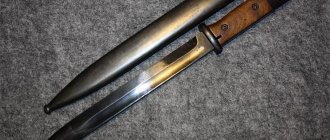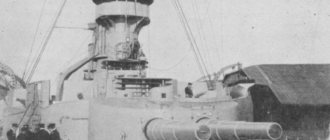Initially, military theorists in many countries around the world were pessimistic about the prospects for using aircraft. Thus, in 1913, German General von Beseler stated that airplanes could not be considered a completely reliable means of warfare. According to the general, “their assistance for reconnaissance and communications ... can be of great importance, but they will never take a decisive part in the fight.” He was echoed by the French newspaper Military France: “The airplane is not a machine of destruction. At least the good thing is that it is now suitable for reconnaissance.”
Airplane Lebed-XII (Russia)
Lebed-XII aircraft
In 1910, Vladimir Aleksandrovich Lebedev graduated from a flight school in France, thus becoming one of the first Russian pilots. In 1912, he organized a workshop for the repair and manufacture of propellers. This small workshop gradually grew into an aircraft manufacturing plant, the first products of which were the French Deperdussin aircraft. With the outbreak of war, Voisins and then FBA flying boats were put into production.
In the summer of 1915, a captured German Albatross reconnaissance aircraft was delivered to the plant, which became the basis for the creation of several types of aircraft of its own design. Having gone through a series of successive modifications, in which mainly the propeller-engine group was subject to modification, the aircraft remained in prototypes.
From the second half of 1915, the production of wooden two-seat reconnaissance biplanes was organized, designated Lebed-XI. The aircraft could not be assigned to any type, since for ten aircraft built there were six variants of the wing box - two and three struts. There is an opinion that repaired captured Albatrosses also fell under the designation Lebed-XI. The aircraft were equipped with restored German Mercedes D.II, Benz Bz.III, Maybach, and Salmson engines. With the latter, the plane was similar to the Lebed-XII, but had a spinner on the propeller and a circular manifold with a vertical exhaust pipe
Instead of the Schneider turret, the rear cabin could be equipped with a machine gun mount by engineer Shkulnik
Based on the captured Albatross S II, Lebed-XII was created. Due to the lack of in-line water-cooled engines, the aircraft was adapted to the Salmson star-shaped one. The engine did not have a cowling and did not fit well into the forward fuselage. The design of the water radiators located on the sides of the fuselage remained German. Despite the increase in drag, the characteristics of the aircraft, compared to the German prototype, changed slightly.
In December 1915, the new vehicle was tested with a Salmson engine (130 hp). The plane was difficult to pilot - there were cases of failure to recover from a dive, and was a fire hazard due to the poor design of the engine exhaust system. For the same reason, exhaust gases blew into the pilot's cabin. Lebed-XII took a long time to be finalized and brought to mass production. It was assumed that the aircraft would be able to replace the outdated Voisins at the front. Aircraft appeared at the front only in the fall of 1916, when their characteristics no longer met the requirements. Soon it was decided to remove them from the arsenal of first-line units and transfer them to aviation schools. However, due to the scarcity of the Russian aviation fleet, the Lebed-XII was operated until the end of the war. After the revolution, the aircraft were used in the civil war and were in service with the Red Army Air Force until 1924. Production of the aircraft continued until 1919. A total of about 216 aircraft were produced, including the training version Lebed T.12. The cadet's cabin was located in front.
The Lebed-XII bis version was equipped with a V-shaped Hispano-Suiza engine (140 hp). The engine hood was sharpened, a spinner was installed on the propeller, and the exhaust pipes were brought up. The plane was manufactured in one copy.
Links[edit]
Notes[edit]
- Claude Roussel, Laurent Friry and Sebastian Faure. Farman De l'aviation à l'automobile
, Ed. Etai, ISBN 9782726897478 - ^ a b "Archive of historical science". Cercle du Mononautisme Classique
(in French). Retrieved July 6, 2022. - Opdycke 1999, p. 264.
- "Brab's" First Flights, Flight
, 28 May 1964, p. 895. - Walter J. Boyne. Air Warfare International Encyclopedia
, ABC-CLIO, INC, ISBN I-57607-345-9 - Green & Swanborough, page 201
- Green & Swanborough, pages 201 and 202
- "Memories of the Essen Raids". Flying
. Vol. 4 things. 1. New York: Flying Association at the office of the Aero Club of America. January 1916 - ^ ab Farman, Avion (1922). "Hydroglisseurs Farman" (press release) (in French). Boulogne-Billancourt, France: Farman aircraft factory. Retrieved July 9, 2022 - via Gallica.
Bibliography[edit]
- Green, William; Gordon Swanborough. The Complete Book of Fighters
. Godalming, UK: Salamander Books. pp. 201, 202. - Opdyke, Leonard E. French Aircraft Before the Great War
Atglen, PA: Schiffer ISBN 1999 0-7643-0752-5
Airplane Farman MF.11 (France)
Airplane Farman MF.11
Brothers Henri and Maurice Farman founded their company back in 1908 and since then have been independently engaged in the design and production of aircraft. Moreover, Henri (F or HF series) tended to use rotary engines on his machines, and Maurice (MF series) - stationary ones. Differences in design approaches were felt in the method of attaching the nacelle and the configuration of the tail.
In 1912, Henri Farman developed the F.15 reconnaissance aircraft, which was a two-seat sesquiplane of mixed design with a pusher propeller. The tail truss was made of steel pipes, and a two-seat gondola was installed on the lower wing. The aircraft was equipped with a Gnome rotary engine or a stationary Salmson “Kanton-Unne” engine. In 1913, the Farman F.15 was adopted by the French Air Force. The aircraft were widely used (including by the British, Italian, Romanian, Russian and Belgian air forces) on the fronts of the First World War until the summer of 1915, and later in training units. No armament was provided, although squadrons sometimes carried a Lewis pin machine gun.
Variants: F.16, MF.20 and F.22 differed in wing area and some minor design and technological modifications. Farman MF.20 began to arrive at the front at the beginning of 1914. They had a different crew nacelle and a tail unit with a “floating” rudder. The gondola was covered with aluminum panels. The power plant was a Gnome rotary engine (100 hp), which was soon replaced by the Salmson “Canton-Unne” (150 hp). In addition, the MF.20 was equipped with Renault engines (160 hp). Three squadrons in France and one in Africa, as well as many aviation schools, were equipped with these aircraft.
The Farman F.22 did not have an anti-cutter ski, and the F.25H was a naval reconnaissance aircraft with a float landing gear. Some types were produced under license in Russia at the Shchetinin, Lebedev and Dux factories (about 500 vehicles of different versions). During the civil war they were used as scouts.
The Farman F.27 was created on the basis of the F.22 and featured an increased lower wing span, as well as the installation of a four-wheeled landing gear. The pilot sat in front. The aircraft was equipped with a Salmson engine (150 hp). 100 cars were produced in France and 50 in Russia. All characteristics have increased significantly. However, by the time it appeared at the front, the F.27 could no longer be considered a good aircraft due to poor maneuverability, and there were also complaints about the strength of the biplane box. They were used on secondary fronts, including by the British.
“British” Farman F.27 with a suspended aerial bomb, the F.27 strongly resembled the “Voisins”
In 1914, Maurice Farman developed a multi-pillar two-seat biplane of mixed design MF.11 with a De Dion engine (100 hp) and a pusher propeller (soon a new Renault water-cooled engine with 130 hp was installed). He had the nickname “Short-horned”, which he received for his shortened anti-cap skis. Its pre-war predecessor, the MF.7, was equipped with highly protruding skis, earning it the nickname "Longhorn". Aircraft of this type made the first night raid (12/21/1914) on German artillery positions.
Until 1917, the Farman MF.11 was widely used on the fronts (except for the Russian one). Built under license in Italy with a Fiat A.10 engine. The aircraft was used by the British on the southern fronts.
In 1915, Maurice created the MF.40 aircraft, which had a modified gondola design in which it was possible to install a Hotchkiss or Lewis turret machine gun.
History of operations[edit]
One of the first examples built was purchased by Roger Sommer, who, just two months after learning to fly, set a new French endurance record with a flight of 1 hour 50 minutes on 1 August 1909, [10] improving it with a flight of 2 hours 27 minutes. 15 seconds taken a week later: This would have been recognized as a new world record if it had been officially set. Sommer later continued to produce aircraft, his first design being taken from Farman.
Sommer's performance was easily surpassed by Farman at the Grande Semaine d'Aviation held in Reims later that month, where he won the 180 km (110 mi) range prize in just under 3 hours 5 minutes at Reims on 27 August. Farman also won a prize for carrying passengers and came second in the height competition. [eleven]
Two examples took part in the aviation meeting held at Blackpool in September 1909, one piloted by Farman and the second by Louis Paulhan, winning first and third prizes for distance flown, and first and second prizes in the speed competitions [12] and At the End October 1909 Polhan made the first demonstration flight at Brooklands in his Farman, watched by a crowd of 20,000 people. In early 1910, Polhan traveled to America to take part in the Los Angeles Air Show, taking on board a Blériot XI and Farman monoplane. At Farman on January 12, he set an altitude record of 1,258 m (4,126 ft). [13]
Farman piloted the type to win the Michelin International Cup, flying 232 km (144 mi) in 4 hours 17 minutes and 53 seconds at Mourmelon on 3 November. [14]
In April 1910, Polhan won the London-Manchester air race in a Farman III, competing against Claude Graham-White, who also flew a Farman.
The type was widely used as a trainer aircraft. By the beginning of 1911, the Aero Club de France had issued 354 pilots' licenses, of which 81 were obtained in Farman III aircraft; the total was exceeded only by 83 pilots who were qualified to fly the Blériot monoplane. [15]
Seven examples were used by the Greek military during the Balkan Wars for reconnaissance. [16]
Airplane Farman F.30 (France)
Airplane Farman F.30
The chronic shortage of aircraft on the Russian fronts, the loss of which for combat and other reasons in combat units reached 37% per month, could not be compensated by supplies from the underdeveloped domestic aviation industry. The deplorable state of combat aviation was aggravated by the lack of modern designs in the production of aircraft and engines. This circumstance forced the command of the Russian army to turn to the allies for help. However, at the initial stage of the war, France and England themselves experienced enormous problems in providing the army in the field, so they were able to supply the Allies with only about 15% of the total production of aircraft and engines.
The F.30 reconnaissance aircraft was designed by the brothers Henri and Maurice Farman on a special order from the Russian military department, which simultaneously purchased a license for its industrial production. The design of the aircraft was standard - an open tail truss and a pusher propeller. The car was considered successful, and the French themselves decided to put it into production.
In December 1915, the first aircraft entered service with French combat air units fighting on the German front. At the initial stage of their combat career, with a small number of enemy fighters, the F.30 quite successfully served as aerial reconnaissance aircraft and (to a lesser extent) day and night bombers as part of the French and Belgian military aviation.
Airplane Farman F.40
Soon, based on the F.30, the next modification of this aircraft was created - the F.40. The new version had increased airframe dimensions, a more streamlined crew nacelle, a modified chassis and a more powerful Renault engine (150 hp). Then the F.41 modification was developed with a reduced upper wing span, F.56 - with a Renault engine (170 hp) and an enlarged radiator, F.60 - with a Renault engine (190 hp) and F.61 - with with the same engine and wings like F.41. However, by 1917 the aircraft was already outdated: it structurally did not meet the requirements of the time and, due to the lack of a rear defensive rifle installation, suffered significant losses from enemy fighters. As a result, in February 1917, the French Aviation Department even issued a special order prohibiting the delivery to the front of aircraft with a pusher propeller power plant.
Since the end of 1916, the F.30 was widely used in Russia, where it became one of the main reconnaissance aircraft and the most popular aircraft of Russian aviation. During the Civil War, it was actively used by both armies and was in service with the Red Army Air Force until 1921, and then was transferred to training units and aviation schools. This longevity was facilitated by the fact that the domestic industry had well mastered the Salmson engine, which was optimally suited for this aircraft. During serial production, engine power constantly increased and on the latest aircraft reached 175 hp. With.
During production, many experiments were carried out regarding the location of the shooting installation. When an observer was placed in a gondola behind the pilot, the machine gun was mounted on a special pyramid above the pilot's head. If the pilot was at the rear of the gondola, a turret with a machine gun was attached to the bow. A modification was produced, F.Z0bis, in which the engine exhaust manifolds were combined into two pipes. More than 400 F.30 aircraft of all modifications were built at (later GAZ No. 1). In mid-1916, Russia also purchased 20 F.40 aircraft.
Background [edit]
In 1907, Henry Farman purchased his first aircraft from Gabriel Voisin and soon began improving the aircraft's design; as a result he was known either as Farman I
or
Voiseneau-Farman
I.
In 1908, after further modifications which included re-coating it with Continental rubberized fabric and adding side curtains, the aircraft was renamed Farman I-bis
. [3] Ailerons were installed following Wilbur Wright's flight demonstration at Le Mans in August 1908.
Second aircraft, named Farman II
, was built by the Voisin brothers with design modifications to Farman's specifications.
Voisin sold the aircraft to JTC Moore-Brabazon, [4] which exported it to England, where it was renamed Bird of Passage
. This episode angered Farman, who in early 1909 ended his collaboration with Voisin and began building his own aircraft.
Aircraft designed and built by Henry Farman were prefixed HF, while those designed and built by his brother Maurice were prefixed MF. [5]
Technical characteristics (type sample 1909)[edit]
Data from
[21]
General characteristics
- Crew:
1 - Capacity:
1 - Length:
12 m (39 ft 4.5 in) - Wingspan:
10 m (33 ft 9.75 in) - Height:
3.5 m (11 ft 6 in) - Wing area:
40 m2 (430.56 sq ft) - Gross weight:
550 kg (1,213 lb) - Powerplant:
1 x Gnome Omega 7-cylinder rotary engine, 37 kW (50 hp)
Play
- Top speed:
60 km/h (37 mph, 32 kn)
Survivors and lines[edit]
Flight replica of Farman III, 2011, Bistrampolis, Lithuania
No original Farman III aircraft is known to have survived.
A replica of the Greek Farman III "Daedalus" is on display at the Athens War Museum (Athens, Greece), a replica of the first German military aircraft Farman III is on display at the Military History Museum Flugplatz Berlin-Gatow (Berlin, Germany), a replica of the Farman III is also exhibited at the National Museum of Science and Technology of Leonardo da Vinci in Milan (Milan, Italy).
A flightable replica with a slightly modified wing profile was built in 2011 by Stasys Cepaitis near Panevezys, Lithuania. [20]

